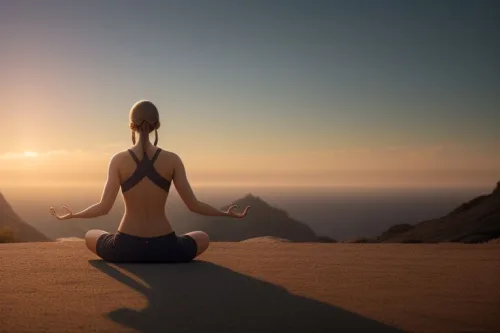

In our fast-paced and demanding lives, finding moments of peace and tranquility can be a challenge. Mindful meditation offers a pathway to escape the chaos and connect with our inner selves. In this comprehensive guide, we will explore the transformative power of mindful meditation, providing valuable insights, practical tips, and step-by-step guidance on how to incorporate this practice into your daily routine. Whether you’re a beginner or have some experience with meditation, this article will equip you with the tools to cultivate mindfulness, reduce stress, and find inner peace amidst the hustle and bustle of life.
Understanding the Essence of Mindful Meditation
What is Mindful Meditation?
Mindful meditation is a practice that involves bringing your attention to the present moment and observing it without judgment. It is about being fully present, accepting whatever arises in your mind, body, and environment, and cultivating a sense of curiosity and compassion towards yourself and others.
The Benefits of Mindful Meditation
Mindful meditation offers numerous benefits that can positively impact your physical, mental, and emotional well-being.
Here are some key advantages:
- Reduced Stress and Anxiety: Mindful meditation allows you to step away from the stressors of daily life and find a calm refuge within yourself. By focusing on the present moment, you can reduce anxiety and promote a sense of inner peace.
- Improved Focus and Concentration: Regular practice of mindful meditation enhances your ability to stay focused and concentrate on tasks. It improves cognitive function and productivity, enabling you to perform better in various aspects of life.
- Enhanced Emotional Well-being: Mindful meditation helps you develop emotional intelligence and resilience. It allows you to observe your thoughts and emotions without getting carried away by them, leading to improved emotional well-being and better relationships.
- Better Physical Health: Mindful meditation has been linked to various physical health benefits, including reduced blood pressure, improved sleep quality, and boosted immune system function. It promotes overall well-being and vitality.
Getting Started with Mindful Meditation
Creating a Sacred Space

Before diving into mindful meditation, it’s essential to create a space that supports your practice. Here’s how you can set up your sacred space:
- Find a Quiet Corner: Look for a quiet and comfortable corner in your home where you can retreat and find solitude. It could be a spare room, a cozy corner in your bedroom, or even a small nook in your living room.
- Personalize Your Space: Decorate your space with objects that inspire and calm you. This could include candles, crystals, plants, or artwork. Surround yourself with items that evoke a sense of tranquility and reflect your personal taste.
Cultivating Mindful Postures
Finding a comfortable posture is essential for practicing mindful meditation. Here are a few options to consider:
- Sitting on a Cushion: Sit cross-legged on a meditation cushion or a folded blanket. Ensure that your spine is straight, but not rigid, and your hips are slightly elevated. Rest your hands on your knees or in your lap.
- Using a Chair: If sitting on the floor is uncomfortable, you can sit on a chair with your feet planted firmly on the ground. Sit with your back straight, shoulders relaxed, and feet flat on the floor.
The Power of Breath

The breath serves as an anchor in mindful meditation. Follow these steps to focus on your breath:
- Find Your Rhythm: Take a moment to settle into your chosen posture. Close your eyes gently or maintain a soft gaze.
- Observe Your Breath: Direct your attention to your breath as it flows in and out. Notice the sensation of the breath entering and leaving your body. Focus on the rise and fall of your abdomen or the feeling of air passing through your nostrils.
- Be Present: Whenever your mind starts to wander, gently bring your attention back to the breath. Don’t judge yourself for getting distracted; it’s natural. Simply acknowledge the thought and return to the breath.
Exploring Different Meditation Techniques
Body Scan Meditation
Body scan meditation involves systematically bringing your awareness to different parts of your body. It promotes relaxation and helps you connect with your physical sensations. Follow these steps:
- Get Comfortable: Find a comfortable position, either lying down or sitting upright.
- Start at the Feet: Bring your attention to your feet and notice any sensations, such as warmth, tingling, or tension. Stay with the sensations for a few breaths before moving on.
- Move Upward: Gradually move your attention upward, scanning each part of your body—ankles, calves, knees, thighs, hips, and so on. Notice any sensations or areas of tension.
- Stay Present: As you encounter areas of tension, breathe into them and consciously release any tightness or discomfort. Bring a sense of gentle curiosity to each part of your body.
Loving-Kindness Meditation
Loving-kindness meditation involves cultivating a sense of love, compassion, and goodwill towards yourself and others. It promotes a positive outlook and nurtures a sense of connection. Follow these steps:
- Set Your Intention: Start by setting an intention for your practice. You can use phrases such as, “May I be happy. May I be healthy. May I live with ease.”
- Visualize a Loved One: Bring to mind someone you love unconditionally. Visualize their face and evoke a feeling of warmth and care.
- Extend Loving-Kindness: Repeat phrases like, “May you be happy. May you be healthy. May you live with ease,” directing them towards the person you visualized. Feel the sense of love and compassion expanding within you.
- Expand Your Circle: Gradually extend the loving-kindness to other loved ones, friends, acquaintances, and eventually to all beings. Cultivate a genuine sense of goodwill towards all living beings.
Integrating Mindfulness into Daily Life
While dedicated meditation sessions are valuable, the ultimate aim is to integrate mindfulness into your daily life. Here are some practical tips:
Mindful Eating
- Slow Down: Instead of rushing through meals, take the time to savor each bite. Notice the flavors, textures, and smells of the food. Chew slowly and be fully present with your meal.
- Engage Your Senses: Pay attention to the colors, shapes, and arrangement of the food on your plate. Appreciate the effort that went into growing and preparing the meal.
- Express Gratitude: Before eating, take a moment to express gratitude for the nourishment the food provides. Reflect on the interconnectedness of all beings involved in bringing the meal to your table.
Mindful Movement
- yoga: Practice yoga as a form of mindful movement. Focus on the sensations in your body, the alignment of your posture, and the breath. Allow yourself to be fully present and in tune with your body.
- Walking Meditation: Take mindful walks in nature or simply around your neighborhood. Pay attention to the sensation of your feet touching the ground, the movement of your body, and the sights and sounds around you.
Mindful Listening
- Be Fully Present: When in conversation with others, be fully present and attentive. Give your undivided attention to the person speaking. Practice active listening and avoid interrupting or formulating responses in your mind.
- Empathy and Understanding: Cultivate empathy and understanding by truly listening to others’ perspectives and experiences. Suspend judgment and approach conversations with an open mind and heart.
Conclusion
Mindful meditation is a powerful tool that can transform your life. By dedicating time each day to cultivating mindfulness, you can reduce stress, enhance focus, and find inner peace amidst the chaos. Remember, mindfulness is a practice, and like any skill, it takes time and consistency to develop. So, be patient with yourself and approach your meditation practice with kindness and curiosity. As you embark on this journey of self-discovery and inner exploration, may you find serenity, clarity, and a deep connection to the present moment.




